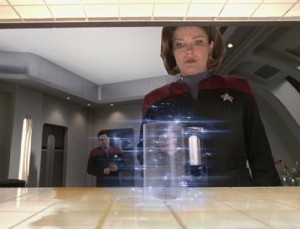Writing About the Next Industrial Revolution
First it was Star Trek’s communicators, which anyone can see are analogous to cell phones.
I mean, really Jim. Is that thing by Motorola or Samsung? 
And look what cell phones did to the telecommunications industry. Then there were those hand held tablets that looked just like those computer-thingies the personnel on Captain Picard’s bridge used to take notes and do their work:
 Come to think of it, the two technologies combined to make iPhones and Androids, right?
Come to think of it, the two technologies combined to make iPhones and Androids, right?
And now . . . drum roll . . . there are replicators. Sort of.
Otherwise known as Makers, and Ray Kurzweil is no doubt proud of this development in the GNR Revolution. The next Apple or Microsoft might very well be any company that develops and brings home-based 3D Maker printing to the wider marketplace by making them simple and accessible and–above all–affordable. It’s in process. Industrial versions of Maker machines used to cost up to a million dollars. But now industrial versions cost $15,000 and home versions are $1,000 each.

Moore’s relentless law will push the price down even further. Yes, the cheaper home version Maker is crude, but so were the first home computers – and look how little we use mainframes now. I see a revolution in manufacturing decentralization. And you know what’s really going to kick it off? Decentralized energy.
Decentralized manufacturing goes hand-in-hand with decentralized energy generation, because manufacturing requires energy. I live in an area with localized hydro plants and have photovoltaic cells on my roof. Both are examples of microgrids, localized groupings of energy generation that can vary from city-sized to individual-sized. Individual microgrids are gradually becoming more and more affordable as the costs of solar panels and wind turbines for energy generation, and lithium and graphene batteries for home energy storage, all go down and their efficiencies rise. (And take a look again at cold fusion: some very interesting things are happening on that front.) Although generally connected to a larger national electricity grid (heck, you can even sell them power), such decentralized energy forms can be disconnected, and a microgrids can function autonomously if a national or regional grid fails as a result of things like natural disasters or wars.
What is all this going to do to manufacturing jobs? For that matter, what is this revolution going to do to centrally-based sources of economic and political power? Science fiction writers have begun to tackle this topic. The first examples of stories about this that spring to my mind are “Nano Comes to Clifford Falls” by Nancy Kress and “Halo” or “Rogue Farm” – both by Charles Stross.
“Nano Comes to Clifford Falls” by Nancy Kress talks about the darker side of future advanced replicator/maker technology. When people can make anything they want, for pretty much free, the will to work for pay disappears. Centralized governments fall. Currencies fail. There’s a mass die-off laced with greed, broken dreams and failed visions. And the only persons left standing in the resultant chaos are those who enjoy work for work’s sake.
“Rogue Farm” is also highly scary. In this written tale (and the animated movie of the same name with a different ending) a group of post-human beings made of former humans use advanced Maker technology to fashion the material of a forest into a rocket ship off this gravity well. This is a growing movement in Stross’ scenario, and nearby humans and their livelihoods be damned. But Stross takes a more positive approach in “Halo.” First the girl-protagonist is issued legal documents, a passport, and other things she needs to escape a hellish situation via an advanced Maker machine (that comes via FedEx). Then she uses highly advanced replicator technology to create a new legal jurisdiction–near Jupiter– to complete her escape.
The 3D printer is cranking up. It hisses slightly, dissipating heat from the hard-vacuum chamber in its supercooled workspace. Deep in its guts it creates coherent atom beams, from a bunch of Bose-Einstein condensates hovering on the edge of absolute zero: by superimposing interference patterns on them, it generates an atomic hologram, building a perfect replica of some original artifact, right down to the atomic level–there are no clunky moving nanotechnology parts to break or overheat or mutate. Something is going to come out of the printer in half an hour, something cloned off its original right down to the individual quantum states of its component atomic nuclei. (from “Halo,” in Accelerando by Charles Stross)
Of course, we’re nowhere near any of the above fictional scenarios. But the stated job of the science fiction writer is to look at what could be: to write cautionary tales, or just to not have their writing look dated in a decade. So if you write in the genre, don’t leave this emerging technology out of your calculations.
Whatever the future holds for Maker technology, it’s going to be interesting. And as the old Chinese curse goes, “May you live in interesting times. ”
Wendy S. Delmater, Editor
Abyss & Apex Magazine

